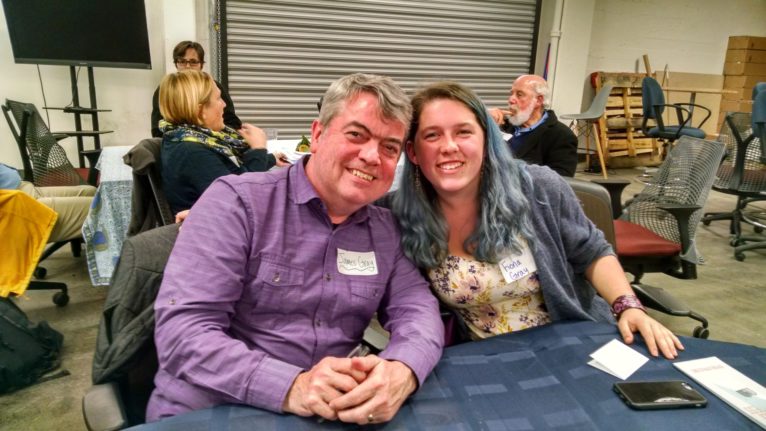By Jon Funabiki
Even San Franciscans accustomed to hearing complaints about soaring housing costs were taken aback when Fiona Gray declared that she might be forced to leave the city.
She is, after all, a cheery-faced Mission High School student still living at home with her parents.
Sitting at a dinner table with her father, James Gray, and other Bay Area residents, Fiona was glum about what the present crisis in housing spells for her future. Many classmates are homeless and depend on free school meals. Homelessness, in effect, had become “normalized” at Mission High, she explained.
“I’m certainly scared about going into the world—and that shouldn’t be a worry for me,” she lamented to her tablemates. “The housing crisis has gotten so bad that it’s affecting all of our lives.”
Fiona was among 44 people who showed up for a dinner sponsored by San Francisco Public Press, which joined other Bay Area news organizations in hosting “On the Table” conversations, an initiative sponsored by Silicon Valley Community Foundation. The foundation recruited volunteers throughout the Bay Area to hold mealtime conversations. Renaissance Journalism liked the idea and we urged news organizations to participate. The idea was to give residents and reporters a chance to exchange thoughts about the housing crisis.
Renaissance Journalism colleague Valerie Bush and I were able to sit in on the San Francisco Press event, which featured salad and enchiladas served at the Impact Hub in the Mission District on Wednesday evening, Nov. 15. Earlier in the day, we joined a two-table Chinese lunch sponsored by KALW Public Radio staffers for residents of the Excelsior District. Two days earlier, we held our own On the Table event for about 50 journalism students at a potluck of sushi, gyoza, homemade brownies and other snacks at San Francisco State University, where I teach.
Everyone involved—journalists, residents, students—seemed to get a lot out of the conversations. By sharing thoughts and concerns, we learned that the housing pressures are affecting people in many profound ways, and that they generate feelings of apprehension and anxiety like the ones expressed by Fiona. At San Francisco State, the students said that the struggle to find apartments made them appreciate the value of “home” and the sacrifices made by their parents to keep a roof over their heads. One student said she texted her mother afterwards to say thank you.
At the KALW lunch, which was held at Henry’s Hunan, a neighborhood hangout, residents said that they were proud that the Excelsior was known as a place where working-class families could establish a “home” that might serve generations. But today’s families are threatened because gentrification is pushing up housing prices and driving developers to turn existing buildings into luxury apartments. These pressures also impact small shops and businesses, and some wondered if Henry’s Hunan might someday be pushed out.
At the San Francisco Public Press dinner, my tablemates ticked through many of the factors that are contributing to the housing squeeze that has pushed the monthly rent for a typical one-bedroom apartment beyond $3,300. Of course, we all realized that the city’s tech boom has drawn in thousands of new, well-paid workers seeking San Francisco’s good life. But other, somewhat invisible factors also are at play. One is California Proposition 13, the 1978 anti-property tax initiative that essentially rewards longtime homeowners, but penalizes new homebuyers. Another is the ability of any resident or organization to stymie new housing developments by lodging protests with city and state agencies. And, some Bay Area cities don’t want new housing developments because it means that more schools, roads and other public services will be needed. Instead, these cities want retail or commercial developments that generate tax dollars and expect neighboring cities to supply the housing.
For some, the situation seemed dire, if not hopeless. An attorney who advocates for the homeless in San Francisco confided that even she felt threatened. “I don’t have any savings,” she said. “I’m one emergency from becoming homeless myself.”
Faced with the reality of a complex problem, my tablemates tried to come up with some positive things that we could to do to alleviate the crisis. Here are some of the more interesting ideas, ranging from the personal to the political:
1. Don’t ignore people who are homeless; offer them assistance. This will help you develop empathy and realize the magnitude of the problem of homelessness.
2. Pressure city and state agencies to adopt a temporary, stopgap planning measure that would streamline the approval process for new housing if developers significantly increase the number of affordable housing units. Even if the plan was only temporary, it could offer much-needed relief to working class families.
3. Persuade San Francisco’s civil grand jury to investigate the causes and solutions to the housing crisis. The findings of such an investigation might stimulate the city’s leaders and voters to take action.
4. Become better informed about housing issues and vote for elected officials who will work on legislation and policies that can have a real impact. One tangible result of the On the Table conversation is that it could shock residents to engage in politics.
While none of these ideas will entirely solve the Bay Area’s housing crisis, it seemed hopeful that a group of strangers, over the time it takes to enjoy delicious enchiladas for dinner, was able to come up with a list of action steps.


